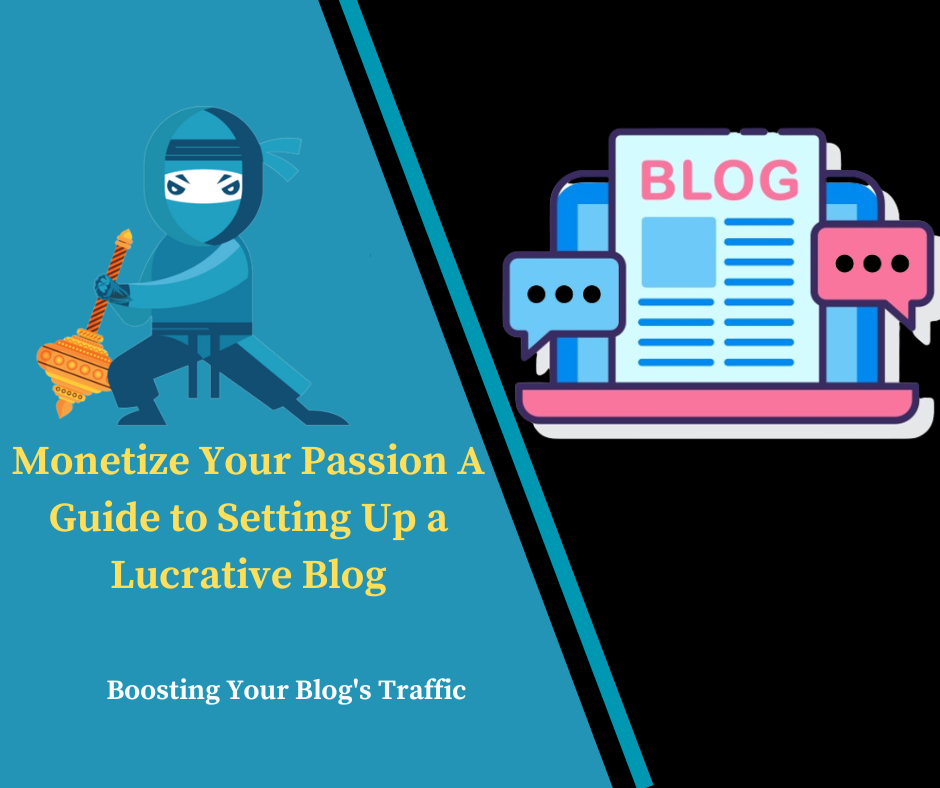Monetize Your Passion: A Guide to Setting Up a Lucrative Blog
In the modern digital landscape, blogging has transcended its early days as a simple online journal and become a robust platform for generating substantial income. If you’re passionate about a specific topic and dream of turning that enthusiasm into a profitable venture, starting a lucrative blog is an excellent strategy. This comprehensive guide will walk you through the essential steps to set up a blog that not only showcases your passion but also generates significant revenue.
1. Understanding What Makes a Blog Lucrative
Before diving into the technical aspects, it’s crucial to understand what makes a blog lucrative. A lucrative blog generates a significant income through various monetization strategies. These can include advertising, affiliate marketing, selling products, or offering premium content. The key to a lucrative blog lies in its ability to attract and engage a targeted audience and convert that engagement into revenue.
Definition of a Lucrative Blog:
A lucrative blog is a content platform designed to generate substantial income through multiple revenue streams, such as ad placements, affiliate marketing, sponsored content, and direct sales.
2. Finding Your Niche
The first step in setting up a lucrative blog is identifying your niche. A niche is a specialized segment of the market that caters to a specific audience. Choosing a niche that aligns with your passion ensures that you’re not only motivated but also knowledgeable about the subject matter. This expertise will help you create valuable content that resonates with your readers.
Also read: How to Turn Your Blog into a Money-Making Machine
How to Choose a Niche:
Passion and Expertise: Select a topic you are passionate about and have substantial knowledge in. Your enthusiasm will reflect in your content and keep you motivated.
Audience Demand: Conduct market research to ensure that there is an audience interested in your chosen topic. Use tools like Google Trends, keyword research, and competitor analysis to gauge demand.
Monetization Potential: Evaluate how you can monetize this niche. Look for existing blogs in the niche and identify their revenue sources.
Example Niches: Technology and gadgets, Travel and adventure, Food and recipes
3. Setting Up Your Blog
With your niche identified, it’s time to set up your blog. Here’s a detailed breakdown of the setup process:
Step 1: Choose a Blogging Platform
WordPress.org: Highly customizable with numerous plugins and themes, ideal for those who want full control.
Wix: Offers a user-friendly interface with drag-and-drop features, suitable for beginners.
Squarespace: Known for its visually appealing design templates, great for those focusing on design and aesthetics.
Step 2: Pick a Domain Name
Relevance: Ensure the domain name reflects your niche and is easy to remember. It should give a clear idea of what your blog is about.
Simplicity: Choose a name that is short, easy to spell, and avoids complex characters.
Step 3: Select a Hosting Provider
Reliability: Opt for a hosting provider known for good uptime and customer support. Providers like Bluehost, SiteGround, and HostGator are popular choices.
Scalability: Ensure the hosting plan can handle future growth as your blog traffic increases.
Step 4: Design Your Blog
Theme: Select a theme that matches your niche and enhances user experience. Both free and premium themes are available.
Customization: Customize the theme to align with your brand identity, including colors, fonts, and layout.
![]()
Step 5: Essential Plugins and Tools
SEO Plugins: Tools like Yoast SEO or Rank Math help optimize your content for search engines.
Analytics: Google Analytics tracks your blog’s performance and user behavior.
Security: Plugins like Wordfence enhance your blog’s security.
4. Creating Valuable Content
Content is the cornerstone of any successful blog. High-quality, engaging content not only attracts readers but also keeps them coming back.
Types of Content to Consider:
How-to Guides: Provide step-by-step instructions on topics relevant to your niche.
Product Reviews: Offer in-depth reviews of products or services related to your niche.
Personal Stories: Share personal experiences and insights to connect with your audience.
Content Strategy:
Consistency: Publish new content regularly to keep your audience engaged and encourage return visits.
SEO Optimization: Incorporate relevant keywords naturally in your content to improve search engine rankings.
Engagement: Use calls to action to encourage comments, shares, and social media interactions.
5. Monetizing Your Blog
To turn your blog into a lucrative venture, explore various monetization strategies:
Affiliate Marketing: Partner with companies to promote their products or services. You earn a commission for each sale made through your referral links.
Advertising: Join ad networks like Google AdSense to display ads on your blog. Revenue is earned based on clicks or impressions.
Sponsored Posts: Collaborate with brands to create content that promotes their products or services in exchange for payment.
Selling Products: Develop and sell digital products (eBooks, online courses) or physical products (merchandise, crafts) that resonate with your audience.
Memberships and Subscriptions: Offer premium content or exclusive access to members who pay a recurring fee.
6. Promoting Your Blog
Effective promotion is essential to growing your blog’s audience and increasing its revenue potential.
Promotion Strategies:
Social Media Marketing: Share your blog posts on platforms like Facebook, Twitter, and Instagram to drive traffic.
Email Marketing: Build an email list and send regular newsletters to keep your audience engaged.
Networking: Connect with other bloggers and influencers to collaborate and expand your reach.
Additional Tips:
SEO Best Practices: Continuously optimize your content for search engines to attract organic traffic.
Paid Advertising: Consider investing in paid ads to reach a broader audience quickly.
FAQ
How long does it take to start earning from a blog?
The time frame varies based on factors like niche, content quality, and marketing efforts. Generally, it can take several months to start seeing significant income, so persistence and consistency are crucial.
Do I need technical skills to set up a blog?
While basic technical skills are helpful, many blogging platforms offer user-friendly interfaces that simplify the setup process. You don’t need advanced skills to get started.
How much does it cost to start a blog?
Initial costs include domain registration, hosting fees, and possibly premium themes or plugins. On average, expect to spend between $100 to $500 annually, depending on your choices.
Can I blog as a side hustle while working a full-time job?
Yes, many successful bloggers start their blogs as a side hustle. Effective time management and setting realistic goals can help you balance blogging with a full-time job.
What are some common mistakes to avoid when starting a blog?
Common mistakes include not thoroughly researching your niche, neglecting SEO, and failing to promote your blog effectively. Addressing these areas can significantly impact your blog’s success.
Conclusion
Monetizing your passion through a blog can be a fulfilling and profitable endeavor, but it requires dedication, strategy, and persistence. By following the steps outlined in this guide, you can transform your interests into a lucrative blog that attracts and engages your target audience. From selecting a niche that resonates with both you and your readers to implementing effective monetization strategies like affiliate marketing, sponsored content, and premium memberships, every aspect plays a crucial role in your blog’s success.








